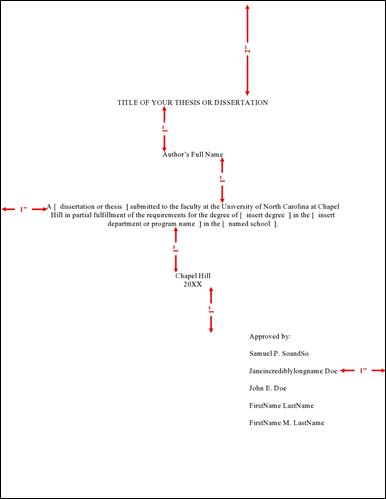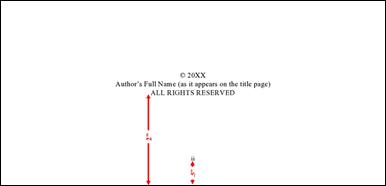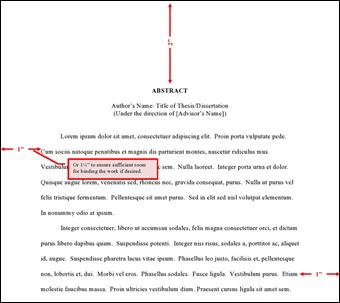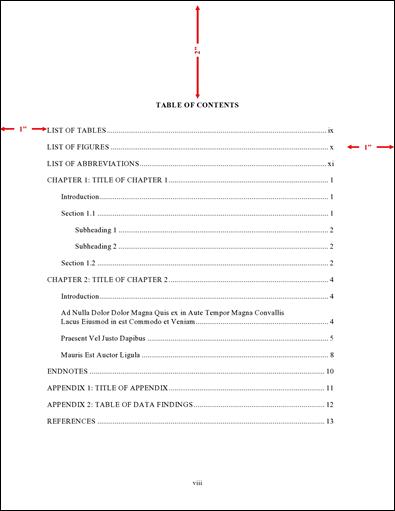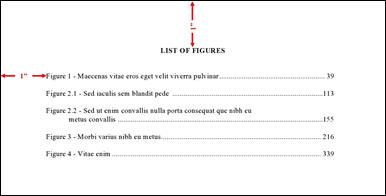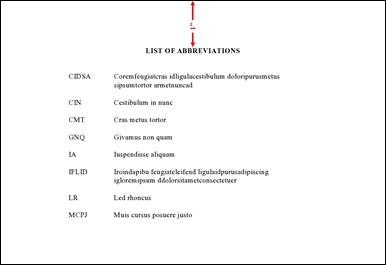
I. Order and Components
Please see the sample thesis or dissertation pages throughout and at the end of this document for illustrations. The following order is required for components of your thesis or dissertation:
- Title Page
- Copyright Page
- Abstract
- Dedication, Acknowledgements, and Preface (each optional)
- Table of Contents, with page numbers
- List of Tables, List of Figures, or List of Illustrations, with titles and page numbers (if applicable)
- List of Abbreviations (if applicable)
- List of Symbols (if applicable)
- Chapters, including:
- Introduction, if any
- Main body, with consistent subheadings as appropriate
- Appendices (if applicable)
- Endnotes (if applicable)
- References (see section on References for options)
Many of the components following the title and copyright pages have required headings and formatting guidelines, which are described in the following sections.
Please consult the Sample Pages to compare your document to the requirements. A Checklist is provided to assist you in ensuring your thesis or dissertation meets all formatting guidelines.
Title Page
The title page of a thesis or dissertation must include the following information:
- The title of the thesis or dissertation in all capital letters and centered 2″ below the top of the page.
- Your name, centered 1″ below the title. Do not include titles, degrees, or identifiers. The name you use here does not need to exactly match the name on your university records, but we recommend considering how you will want your name to appear in professional publications in the future.
- The following statement, centered, 1″ below your name: “A [ dissertation or thesis ] submitted to the faculty at the University of North Carolina at Chapel Hill in partial fulfillment of the requirements for the degree of [ insert degree ] in the [ insert department or program name ] in the [ named school ].” End this statement with a period.
Notes on this statement:
- When indicating your degree in the second bracketed space, use the full degree name (i.e., Doctor of Philosophy, not Ph.D. or PHD; Master of Public Health, not M.P.H. or MPH; Master of Social Work, not M.S.W. or MSW).
- List your department, school, or curriculum rather than your subject area or specialty discipline in the third bracketed space. You may include your subject area or specialty discipline in parentheses (i.e., Department of Romance Languages (French); School of Pharmacy (Molecular Pharmaceutics); School of Education (School Psychology); or similar official area).
- If you wish to include both your department and school names, list the school at the end of the statement (i.e., Department of Pharmacology in the School of Medicine).
- Complete examples:
- A dissertation submitted to the faculty at the University of North Carolina at Chapel Hill in partial fulfillment of the requirements for the degree of Doctor of Philosophy in the Department of Public Policy.
- A thesis submitted to the faculty at the University of North Carolina at Chapel Hill in partial fulfillment of the requirements for the degree of Master of Science in the School of Dentistry (Endodontics).
- A thesis submitted to the faculty at the University of North Carolina at Chapel Hill in partial fulfillment of the requirements for the degree of Master of Science in the Department of Nutrition in the Gillings School of Global Public Health.
- A dissertation submitted to the faculty at the University of North Carolina at Chapel Hill in partial fulfillment of the requirements for the degree of Doctor of Philosophy in the School of Education (Cultural Studies and Literacies).
- The words “Chapel Hill” must be centered 1″ below the statement.
- One single-spaced line below that, center the year in which your committee approves the completed thesis or dissertation. This need not be the year you graduate.
- Approximately 2/3 of the way across the page on the right-hand side of the page, 1″ below the year, include the phrase “Approved by:” (with colon) followed by each faculty member's name on subsequent double-spaced lines. Do not include titles such as Professor, Doctor, Dr., PhD, or any identifiers such as “chair” or “advisor” before or after any names. Line up the first letter of each name on the left under the “A” in the “Approved by:” line. If a name is too long to fit on one line, move this entire section of text slightly to the left so that formatting can be maintained.
- No signatures, signature lines, or page numbers should be included on the title page.
Copyright Page
Include a copyright page with the following information single-spaced and centered 2″ above the bottom of the page:
© Year
Author's Full Name (as it appears on the title page)
ALL RIGHTS RESERVED
This page immediately follows the title page. It should be numbered with the lower case Roman numeral ii centered with a 1/2″ margin from the bottom edge.
Inclusion of this page offers you, as the author, additional protection against copyright infringement as it eliminates any question of authorship and copyright ownership. You do not need to file for copyright in order to include this statement in your thesis or dissertation. However, filing for copyright can offer other protections.
See Section IV for more information on copyrighting your thesis or dissertation.
Abstract
Include an abstract page following these guidelines:
- Include the heading “ABSTRACT” in all capital letters, and center it 2″ below the top of the page.
- One double-spaced line below “ABSTRACT”, center your name, followed by a colon and the title of the thesis or dissertation. Use as many lines as necessary. Be sure that your name and the title exactly match the name and title used on the Title page.
- One single-spaced line below the title, center the phrase “(Under the direction of [advisor's name])”. Include the phrase in parentheses. Include the first and last name(s) of your advisor or formal co-advisors. Do not include the name of other committee members. Use the advisor's name only; do not include any professional titles such as PhD, Professor, or Dr. or any identifiers such as “chair” or “advisor”.
- Skip one double-spaced line and begin the abstract. The text of your abstract must be double-spaced and aligned with the document's left margin with the exception of indenting new paragraphs. Do not center or right-justify the abstract.
- Abstracts cannot exceed 150 words for a thesis or 350 words for a dissertation.
- Number the abstract page with the lower case Roman numeral iii (and iv, if more than one page) centered with a 1/2″ margin from the bottom edge.
Please write and proofread your abstract carefully. When possible, avoid including symbols or foreign words in your abstract, as they cannot be indexed or searched. Avoid mathematical formulas, diagrams, and other illustrative materials in the abstract. Offer a brief description of your thesis or dissertation and a concise summary of its conclusions. Be sure to describe the subject and focus of your work with clear details and avoid including lengthy explanations or opinions.
Your title and abstract will be used by search engines to help potential audiences locate your work, so clarity will help to draw the attention of your targeted readers.
Dedication, Acknowledgements, Preface (optional)
You have an option to include a dedication, acknowledgements, or preface. If you choose to include any or all of these elements, give each its own page(s).
A dedication is a message from the author prefixed to a work in tribute to a person, group, or cause. Most dedications are short statements of tribute beginning with “To…” such as “To my family”.
Acknowledgements are the author's statement of gratitude to and recognition of the people and institutions that helped the author's research and writing.
A preface is a statement of the author's reasons for undertaking the work and other personal comments that are not directly germane to the materials presented in other sections of the thesis or dissertation. These reasons tend to be of a personal nature.
Any of the pages must be prepared following these guidelines:
- Do not place a heading on the dedication page.
- The text of short dedications must be centered and begin 2″ from the top of the page.
- Headings are required for the “ACKNOWLEDGEMENTS” and “PREFACE” pages. Headings must be in all capital letters and centered 2″ below the top of the page.
- The text of the acknowledgements and preface pages must begin one double-spaced line below the heading, be double-spaced, and be aligned with the document's left margin with the exception of indenting new paragraphs.
- Subsequent pages of text return to the 1″ top margin.
- The page(s) must be numbered with consecutive lower case Roman numerals (starting with the page number after the abstract) centered with a 1/2″ margin from the bottom edge.
Table of Contents
Include a table of contents following these guidelines:
- Include the heading “TABLE OF CONTENTS” in all capital letters, and center it 2″ below the top of the page.
- Include one double-spaced line between the heading and the first entry.
- The table of contents should not contain listings for the pages that precede it, but it must list all parts of the thesis or dissertation that follow it.
- If relevant, be sure to list all appendices and a references section in your table of contents. Include page numbers for these items but do not assign separate chapter numbers.
- Entries must align with the document's left margin or be indented to the right of the left page margin using consistent tabs.
- Major subheadings within chapters must be included in the table of contents. The subheading(s) should be indented to the right of the left page margin using consistent tabs.
- If an entry takes up more than one line, break up the entry about three-fourths of the way across the page and place the rest of the text on a second line, single-spacing the two lines.
- Include one double-spaced line between each entry.
- Page numbers listed in the table of contents must be located just inside the right page margin with leaders (lines of periods) filling out the space between the end of the entry and the page number. The last digit of each number must line up on the right margin.
- Information included in the table of contents must match the headings, major subheadings, and numbering used in the body of the thesis or dissertation.
- The Table of Contents page(s) must be numbered with consecutive lower case Roman numerals centered with a 1/2″ margin from the bottom edge.
Lists of Tables, Figures, and Illustrations
If applicable, include a list of tables, list of figures, and/or list of illustrations following these guidelines:
- Include the heading(s) in all capital letters, centered 1″ below the top of the page.
- Include one double-spaced line between the heading and the first entry.
- Each entry must include a number, title, and page number.
- Assign each table, figure, or illustration in your thesis or dissertation an Arabic numeral. You may number consecutively throughout the entire work (e.g., Figure 1, Figure 2, etc.), or you may assign a two-part Arabic numeral with the first number designating the chapter in which it appears, separated by a period, followed by a second number to indicate its consecutive placement in the chapter (e.g., Table 3.2 is the second table in Chapter Three).
- Numerals and titles must align with the document's left margin or be indented to the right of the left page margin using consistent tabs.
- If an entry takes up more than one line, break up the entry about three-fourths of the way across the page and place the rest of the text on a second line, single-spacing the two lines.
- Include one double-spaced line between each entry.
- Page numbers must be located just inside the right page margin with leaders (lines of periods) filling out the space between the end of the entry and the page number. The last digit of each number must line up on the right margin.
- Numbers, titles, and page numbers must each match the corresponding numbers, titles, and page numbers appearing in the thesis or dissertation.
- All Lists of Tables, Figures, and Illustrations page(s) must be numbered with consecutive lower case Roman numerals centered with a 1/2″ margin from the bottom edge.
List of Abbreviations
If you use abbreviations extensively in your thesis or dissertation, you must include a list of abbreviations and their corresponding definitions following these guidelines:
- Include the heading “LIST OF ABBREVIATIONS” in all capital letters, and center it 1″ below the top of the page.
- Include one double-spaced line between the heading and the first entry.
- Arrange your abbreviations alphabetically.
- Abbreviations must align with the document's left margin or be indented to the right of the left page margin using consistent tabs.
- If an entry takes up more than one line, single-space between the two lines.
- Include one double-spaced line between each entry.
- The List of Abbreviations page(s) must be numbered with consecutive lower case Roman numerals centered with a 1/2″ margin from the bottom edge.
List of Symbols
If you use symbols in your thesis or dissertation, you may combine them with your abbreviations, titling the section “LIST OF ABBREVIATIONS AND SYMBOLS”, or you may set up a separate list of symbols and their definitions by following the formatting instructions above for abbreviations. The heading you choose must be in all capital letters and centered 1″ below the top of the page.
